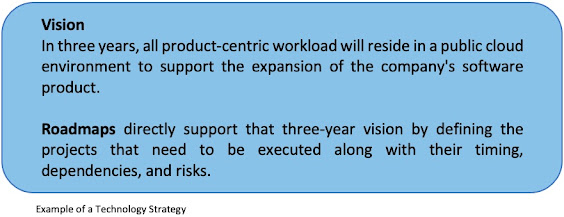Before we dive into why I believe Enterprise Architecture (EA) and Technology Strategy should belong within the same organization, I would like to take a moment to review some definitions. There are many ways to define these two functions based on how they are deployed within an enterprise and the problems that they are designed to address. My attempt here is to keep the following descriptions at a high level to incorporate all the common variations of Enterprise Architecture and Technology Strategy.
What is Enterprise Architecture?
Enterprise Architecture, at its core, focuses on ensuring that technology is aligned with business strategy and applied or adopted in such a way that technical debt is minimized. Additionally, functional, and technical fitness is measured along with the level of compatibility with existing technical architectures. The artifacts of EA include a view of the entire enterprise in the form of Business Capability Models and Architectural Models that represent every supporting business function. Applications, supporting infrastructure, life cycles, and their consumers are then mapped to these artifacts along with costs to create a comprehensive view of all technology within the enterprise. Armed with this data, and utilizing an EA tool, transformational change can begin that enables smarter decision making, which will ultimately reduce technical debt, drive down operational costs, and drive symmetry across organizations or functions.
What is Technology Strategy?
The primary goal of a Technology Strategy is to support a business strategy. In turn, IT is empowered to better prioritize initiatives, plan for organizational changes, and enable more accurate budget forecasting. A Technology Strategy contains a pragmatic view of the future in the form of a vision and a set of roadmaps that describe how to achieve that vision. Roadmaps can be comprised of programs and projects executed over time or milestones that need to be achieved in a certain order. Below is an example of a Technology Strategy:
Why should EA and Technology Strategy be in the same organization?
By describing both functions within one statement, one can begin to see how they work together to achieve a common goal:
Enterprise Architecture describes the business through business capability models along with supporting business processes and technologies, whereas Technology Strategies describe how to enable those business capabilities through the change or adoption of technology over time.
Now that we understand what EA and Technology Strategies are, let’s explore three reasons that they should exist within the same organization.
Benefit #1 - Reduced risk of deploying the wrong technology
EA understands the complexity of the current technology environment along with how each technical component supports the business. EA also understands the impact and risk of incurring change within any part of the technical landscape. Technology strategy needs to leverage that knowledge and work harmoniously with EA to agree on a future state that is technically achievable, technically fit, and directly supports the defined business capability. Additionally, the technology deployed over time that is represented in the technology strategy roadmap must align with the current architecture to avoid disruption to the business or unplanned costs. With EA and Technology Strategy in the same org, the chances of business disruption due to poor architectural decisions can be significantly reduced.
Benefit #2 - They have the same 'North Star'
Both EA and Technology Strategies are focused on the same thing, reduction of technical debt and improved (or enabled) business outcomes. The two functions are complimentary and rely on each other to paint a comprehensive picture of the current technical enterprise, the future technical enterprise and what investments in technology will need to be made over time to reach the 'North Star'.
Benefit #3 - They leverage each other to achieve a durable outcome
Both EA and Technology Strategies are tasked with enabling technology to support business strategy and business outcomes. Decisions to adopt technology should not be made lightly and need to address attributes such as scalability, affordability, and durability. EA understands the complexity of currently deployed technology and can provide guidance during the authorship of related technology strategies to ensure these three attributes are addressed. Without a tightly coupled partnership between EA and Technology Strategy, the risk of deploying technology that does not meet the longer term needs of the business is greatly increased.
I would love to hear your thoughts about this topic so please post a comment so that we can begin a dialog. Lastly, I am compelled to share that AI had no part in the authoring of this article. Being a self-proclaimed Pragmatic Futurist, the irony of this statement does not escape me….


Comments
Post a Comment